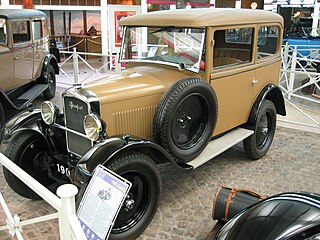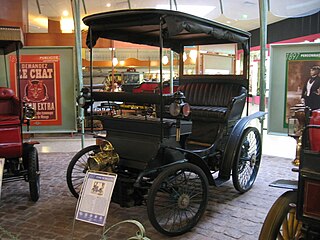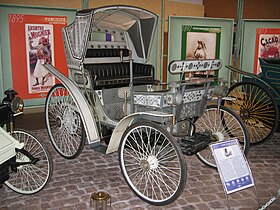
Peugeot is a French brand of automobiles owned by Stellantis. The family business that preceded the current Peugeot companies was founded in 1810, and it is regarded as the oldest car company in the world. On 20 November 1858, Émile Peugeot applied for the lion trademark. Armand Peugeot (1849–1915) built the company's first car steam tricycle. They joined forces with Léon Serpollet in 1886; this was followed in 1890 by an internal combustion car with a Panhard-Daimler engine.

The V6 PRV engine is an automobile petrol V6 engine that was developed jointly by Peugeot, Renault and Volvo Cars – and sold from 1974 to 1998. It was gradually replaced after 1994 by another joint PSA-Renault design, known as the ES engine at PSA and the L engine at Renault. It was designed and manufactured by the company "Française de Mécanique" for PSA, Renault and Volvo.

The Peugeot 504 is a mid-size, front-engine, rear-wheel-drive automobile manufactured and marketed by Peugeot from 1968 to 1983 over a single generation, primarily in four-door sedan and wagon configurations – but also as twin two-door coupé and cabriolet configurations as well as pickup truck variants.

The Peugeot 104 is a supermini car produced by the French company Peugeot between 1972 and 1988. It was designed by Paolo Martin was initially only sold as a four-door saloon car, with a three-door hatchback variant introduced in 1974 and a five-door hatchback version replacing the saloon in 1976. The 104 was the first model produced at the company's Mulhouse plant. It was also the first new Peugeot introduced since 1955 not to be offered in a diesel version.

The Peugeot 1007 is a small three-door car manufactured by Peugeot from 2004 to 2009, noted for its user-swappable interior trim pieces and its four pillar design incorporating two power sliding doors. It shares its platform with the Peugeot 206, Citroën C2 and Citroën C3. Sales commenced in April 2005 in Europe.

De Dion-Bouton was a French automobile manufacturer and railcar manufacturer, which operated from 1883 to 1953. The company was founded by the Marquis Jules-Albert de Dion, Georges Bouton, and Bouton's brother-in-law Charles Trépardoux.

The Peugeot 207 is a supermini car (B) that was designed and produced by the French automaker Peugeot from 2006 to 2014. It was presented at the Geneva Motor Show in 2006, and entered production in April 2006, as the successor to the Peugeot 206. It shares the same platform with the Citroën C3.

The Peugeot 308 is a small family car produced by French automobile manufacturer Peugeot. It was unveiled in June 2007, and launched in September 2007 in hatchback form, which was followed by station wagon in March 2008, coupé cabriolet in February 2009, and a sedan version in February 2010. The 308 replaced the 307, and positioned below the 508 and above the smallest 208.

The Peugeot 208 is a supermini car produced by the French automaker Peugeot. Unveiled at the Geneva Motor Show in March 2012 and positioned below the larger 308. The 208 replaced the 207 in 2012, and the car is currently at its second generation.

The Peugeot 201 is a car produced by Peugeot between 1929 and 1937.

The Peugeot 402 is a large family car produced by Peugeot in Sochaux, France, from 1935 to 1942. It was unveiled at the Paris Motor Show in 1935, replacing the Peugeot 401.

The Peugeot Type 190 S is a model of Peugeot produced between 1928 and 1931.

The Peugeot Type 5 was a small car by Peugeot, produced from 1893 to 1896. Mechanically, little was changed from the Peugeot Type 3. The engine and most of the mechanical parts were unchanged, but the car was shorter, lighter, and correspondingly made more of its 2 horsepower. However, against larger models from Peugeot, this car did not fare well. A total of 14 were sold.

The Peugeot Type 16 was a mid-size family car produced by French automaker Peugeot from 1897 to 1900. The flat-twin engine was of the same series produced in the contemporaneous Peugeot Type 15, though the engine in the heavier Type 16 was enlarged to 2.4 L. During the production run, the Type 16 was joined in its class by the smaller Peugeot Type 17, the similar Type 19, and the larger Type 32. A total of 87 Type 16s were built.
The Peugeot Type 66 was the first large car from French automaker Peugeot, as well as the first vehicle from that manufacturer to have four cylinders. Most were made as closed-top limousines. The engine displaced 5.0 L and produced 25 horsepower (19 kW), which was sufficient to carry the car to a top speed of 87 kilometres per hour (54 mph). Production ran throughout 1904 and a total of 20 were built.

Charles Henry Philippe Lévêque de Vilmorin was a French botanist, the son of Pierre François "Louis" Lévêque de Vilmorin (1816-1860) and Elisa Bailly (1826-1868), and grandfather of the novelist, poet and journalist, Louise de Vilmorin. Seven generations of the family of Vilmorin contributed greatly to French agriculture for over two hundred and thirty years by their improvements of sugar-beet and wheat - they published more than three hundred and sixty articles on plants in agriculture, horticulture, floriculture and botany.

Paris–Rouen, Le Petit Journal Horseless Carriages Contest, was a pioneering city-to-city motoring competition in 1894 which is sometimes described as the world's first competitive motor race.

The Peugeot Type 7 was built on the same chassis as the Peugeot Type 6 and shared some mechanicals but its engine was twice the size, and twice as powerful. It had a phaeton style body for 4 persons. 25 units were built between 1894 and 1897. The engine was carried over to the Type 8.
The Paris–Marseille–Paris race was the first competitive 'city to city' motor race originating in Paris, where the first car across the line was the winner, prior events having selected the winner by various forms of classification and judging. The race was won by Émile Mayade who completed the ten-day, 1,710 km, event over unsurfaced roads in 67 hours driving a Panhard et Levassor.

Société des Automobiles Bellanger Frères was a French automobile manufacturer between 1912 and 1925. The cars were the brainchild of Robert Bellinger (1884-1966), who had previously sold Delaunay-Belleville vehicles.


















